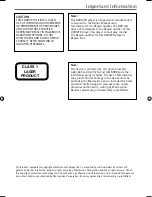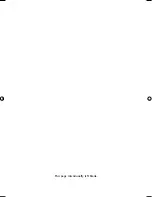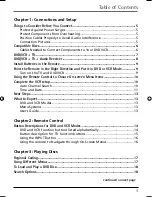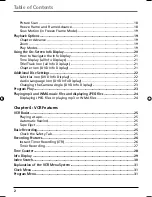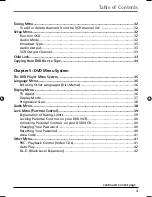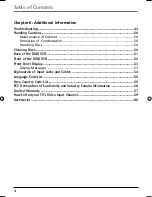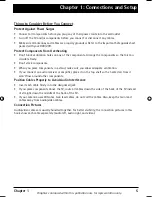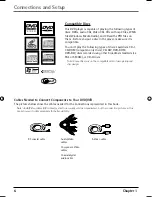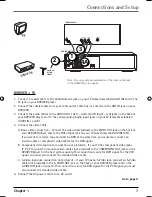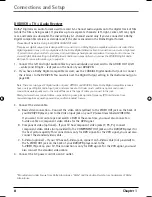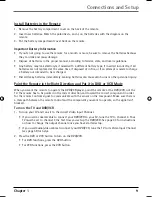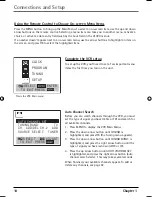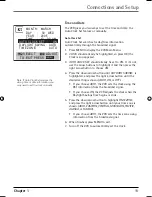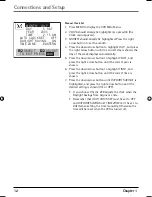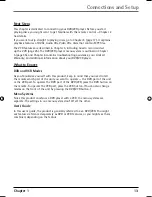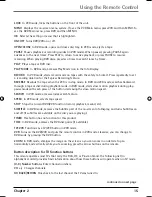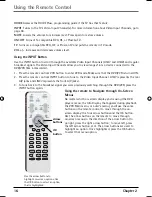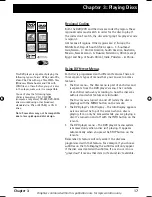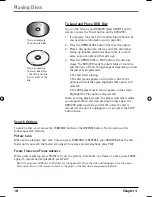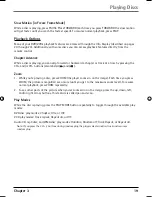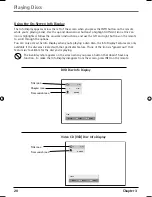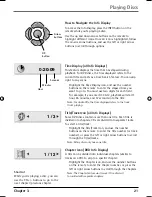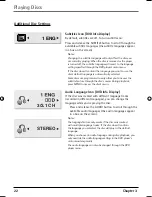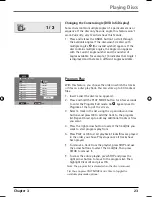
8 Chapter
1
Connections and Setup
DVD/VCR + TV + Audio Receiver
Dolby* Digital is an audio format used to record 5.1-channel audio signals onto the digital track of fi lm
(while the fi lm is being made). It provides up to six separate channels: left, right, center, left rear, right
rear, and common subwoofer. The disc will play 5.1-channel sound only if you’ve connected a Dolby
Digital compatible receiver or decoder and if the disc is encoded in the Dolby Digital format.
Please Read This Before Using the DIGITAL AUDIO OUT Jack!
This player’s digital output jack is designed for a connection to a Dolby Digital compatible receiver or decoder. Older
digital equipment may not be compatible with the Dolby Digital bitstream. Such a connection can create a high level
of noise that may be harmful to your ears, and could damage headphones or speakers. It is important to choose the
correct Digital Output setting in the DVD player’s Audio menu, especially when you use the COAXIAL Digital Audio
Out jack. For more information, go to page 38.
1. Connect the left and right audio cables to your audio/video receiver and to the AUDIO OUT L (left
– white) and R (right – red) jacks on the back of your DVD/VCR.
2. If you have a Dolby Digital compatible receiver, use the COAXIAL Digital Audio Out jack to connect
the receiver to the DVD/VCR. You must also set the
Digital Output
setting in the
Audio
menu (go to
page 38).
Note: There are two types of digital audio out jacks: OPTICAL and COAXIAL. Some Dolby Digital compatible receivers
have one type of Digital Audio Input jack, and some have both. Under most conditions, optical and coaxial
connections work equally well — the only difference is the type of cable you connect to the jack.
Rarely, but sometimes, coaxial cables — especially long ones, pick up radio frequency (RF) interference from
household appliances, nearby power lines, and/or broadcast towers.
3. Connect the video cable.
A. Basic video connection – Connect the video cable (yellow) to the VIDEO OUT jack on the back of
your DVD/VCR player, and to the Video Input jack on your TV (sometimes labeled VIDEO IN).
If you want to record a tape and watch a DVD at the same time, you must also connect an
S-video cable or component video cables for the DVD signal.
B. Component video (optional) – If your TV has component video jacks (Y, Pb, Pr), connect
component video cables (not provided) to the COMPONENT OUT jacks on the DVD/VCR player for
the best picture quality. This connection is only for DVD signal. For the VCR signal, you must also
connect the standard video cable.
C. S-Video (optional) – If your TV has an S-Video jack, connect an S-Video cable (not provided) to
the S-VIDEO OUT jack on the back of your DVD/VCR player and to the
S-VIDEO IN jack on your TV. This connection is only for DVD signal. For the VCR signal, you must
also connect the standard video cable.
4. Connect the AC power cord into an AC outlet.
* Manufactured under license from Dolby Laboratories. “Dolby” and the double-D symbol are trademarks of Dolby
Laboratories.
16566560e book file.indb 8
16566560e book file.indb 8
4/27/05 4:51:51 PM
4/27/05 4:51:51 PM



